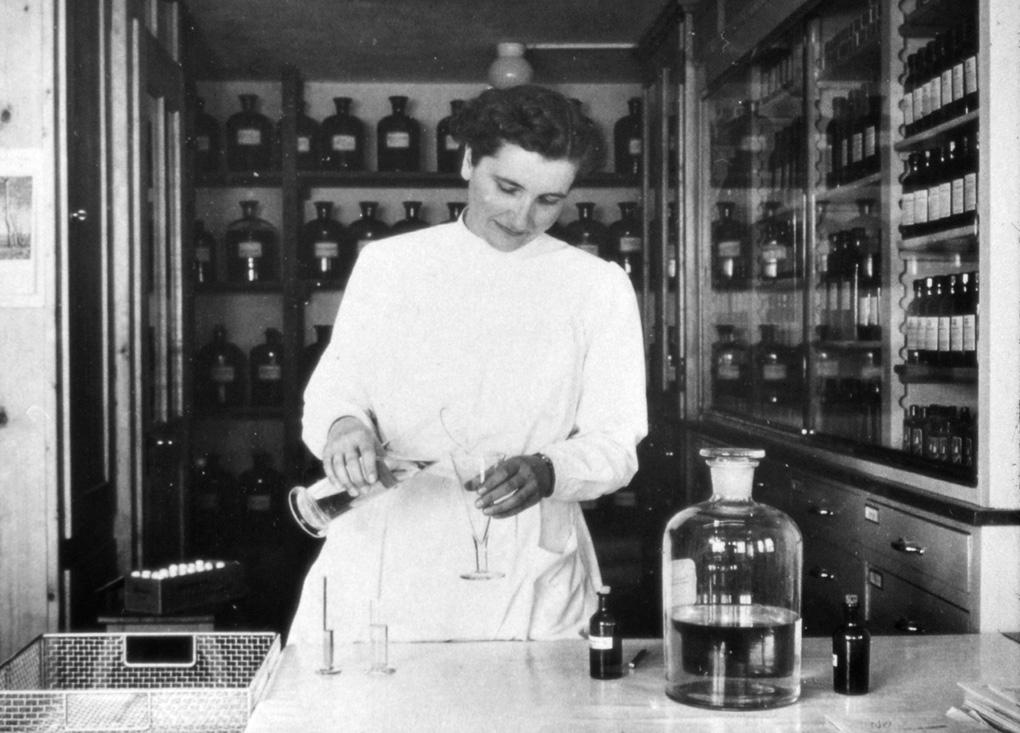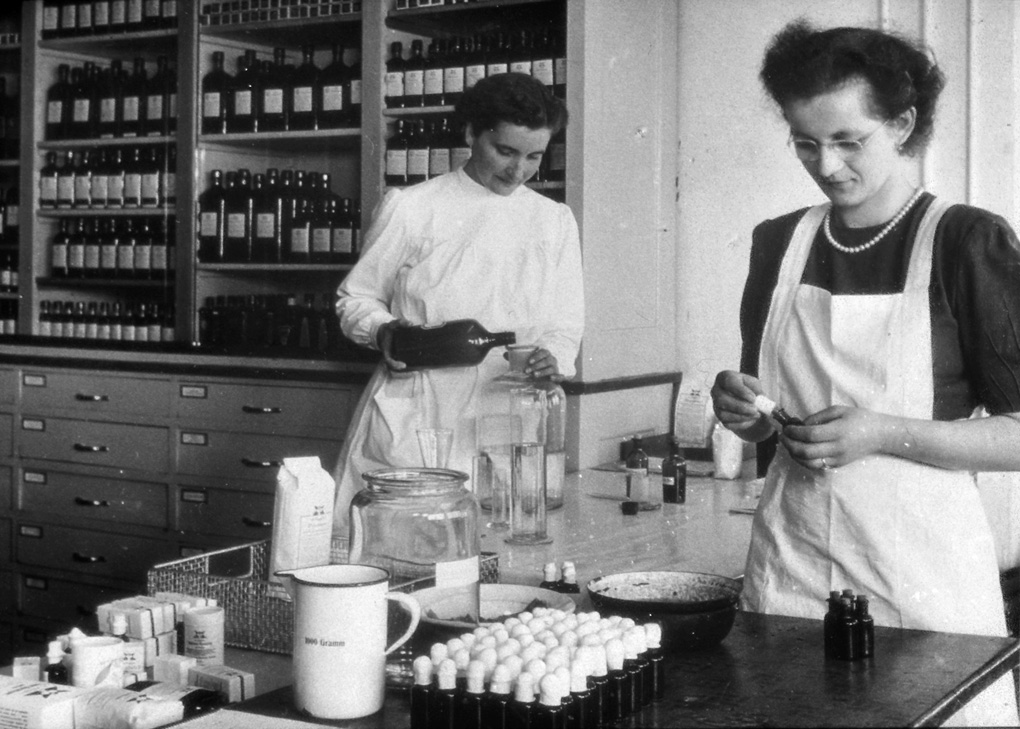A.Vogel search
When the internal search is activated, personal data such as your IP address is transmitted to our search engine Cludo. Data is thus transferred to a third country. Please click here if you want to display the internal search. You can find more information on data protection here: Privacy policy.
From Alfred Vogel's health resort and children's home to the modern Hätschen property in Teufen
A look back at the beginnings of naturopathy pioneer Alfred Vogel and a look ahead at the upcoming structural redesign of the Hätschen property in Teufen
After the opening of the new A.Vogel Visitor Centre in Teufen two years ago, the conversion of the Hätschen will enter the next phase in October 2022. Now it's time for the three old houses above the beautiful new building. Two new buildings will take their place by spring 2024, reviving the incomparable "spirit" of the A.Vogel site in a new freshness.
Author: Clemens Umbricht
Hardly any visitor can escape the charm that Alfred Vogel's place of work in Teufen exudes. The three original houses of A.Vogel's founder - the health resort and children's home, the building of today's museum and the publishing house - form a unique ambience together with the medicinal plant show garden, the visitor centre and the Alpstein panorama. As enchanting as the garden is with its splendour of plants - the houses above the garden are now getting on in years. Their building substance has become so dilapidated that renovation would only be possible at disproportionately high cost. The three buildings will therefore be demolished from October and replaced by two new houses. The legacy of the naturopathy pioneer Alfred Vogel (1902 - 1996) will be preserved in this way. Because it all started in Teufen at the beginning of the 1930s.

Alfred Vogel's three buildings in Teufen (1970)
A busy start at "more than 900 metres"
Alfred Vogel, then 31 years old, moved with his first wife Sophie (née Sommer, 1901 - 1982) from Basel to Appenzellerland in 1933. Initially, the couple lived in Speicher with their two daughters Ruth (1928 - 1993) and Maya (1929 - 2009). A short time later, the family moved to Trogen and finally to Teufen in 1937. In September of the same year, they acquired the Hätschen property. Here Alfred Vogel set up a health resort and children's home and began his work as a naturopath.
"The health resort", writes Alfred Vogel in internal notes in his estate, "was built according to modern, healthy principles, with underfloor heating, open-air cavities in the walls, a pure wooden building at a sunny altitude, about 900 m above sea level with a view of the Alpstein region, especially of the Säntis." In 1972 Alfred Vogel looks back on it in "Gesundheits-Nachrichten" (engl. "Healthy News"): "When I settled in Teufen in 1937, I had to plant my garden at an altitude of more than 900 metres. However, the clay soil was so condensed and sticky that it was more suitable for brickworks.... I racked my brain over the unfavourable soil conditions, as I wanted to plant a respectable medicinal plant culture in addition to growing vegetables."1
In said prospectus, Alfred Vogel explained that patients in Teufen would be treated according to the "natural healing method". This means with "diet ... physical therapy and the natural remedies, be it with homoeopathy, biochemistry or clay and water treatment". Alfred Vogel's health resort in the three-storey building had room for 15 guests. They should not enjoy the panoramic view of the Alpstein mountain range with pure idleness, but be active and lend a hand. For Alfred Vogel, working in the garden, plenty of exercise and fresh air were always part of the "natural therapy".
The years of World War
The years of the Second World War brought restrictions and privations. While the war raged around Switzerland, Alfred Vogel worked on his plans for the future at the Hätschen. One of them was for his magazine. The paper, which had been published since 1929 under the name "Das neue Leben", had appeared only irregularly, if at all, in recent years. Lina Siegrist, who was Alfred Vogel's sole employee at the time, reports in her memoirs that she had to type on an old typewriter: "Alfred Vogel said that unfortunately it was not possible for him to buy a new one"2.

Alfred Vogel in his office in Bever (GR)
From the end of 1945, Alfred Vogel began to publish the journal regularly under the name "Gesundheits-Nachrichten" (engl. "Healthy News") in twelve issues, initially thin and printed in newspaper format. He was able to count on the active help of his wife, the primary school teacher Sophie; she edited each issue and added a poem. At the same time, he distributed his naturopathic "specialities" to an increasing number of drugstores and health food shops. Economic conditions improved. Soon he could afford a car, a Tatra. In sun, rain and snow, he bumped up and down the steep road to Hätschen - 20 percent gradient on the then unpaved dirt road...
The first "small factory"

The success of the "Health Resort Vogel" and the sale of the products gave Alfred Vogel a boost. This enabled him to build a new production building between 1942 and 1947, and, slightly lower down, a residential building, each with two and three storeys respectively. Finally, he was able to extract fresh plant juices from medicinal herbs on a larger scale. His "little factory" - as he once called it - contained a large hydraulic press for extracting plant juice, a modern vacuum system, an autoclave (pressure vessel) and a straining machine with tabletting machines and dragée kettles. This also included a series of so-called percolators, in which water heated by overpressure released the active ingredients from the freshly harvested plants. At times, there must have been a hectic hustle and bustle at the Hätschen: Patients came and went, the garden was weeded and planted, herbs and berries were gathered, cooking and steaming took place, plant juices were fermented, natural remedies were produced and, on top of that, milk sheep were bred and sold ...

A.Vogel Publishing House, 2022
In the new residential building - where the publishing house A.Vogel is located today - the Vogels moved into the first floor. On the ground floor - in what is now the publishing house's forwarding department - a small flat for employees was set up in "Appenzeller size", i.e. with low door frames (1.8 m) and a room height of two metres.
In addition to all his busy activities, Alfred Vogel also appeared for the first time on a larger scale as a publicist and lecturer during these years. But soon it became too much for him. In May 1946 he wrote in his magazine: The increasing number of requests and the lack of reliable staff "have caused me to limit my consultations to 3 days a week, Mon, Tue, Wed from 2am to 6am."3 Telephone enquiries would strictly be answered only during "office hours". "We are looking," he wrote emphatically, "for assistants like pins".
Exploratory spirit and world traveller

Alfred Vogel's Teufen business flourished, thanks in part to the helpers to whom Alfred Vogel increasingly left the day-to-day running of the business. He soon embarked on his first research trips, visited the USA and discovered the red coneflower (lat. Echinacea purpurea) for himself. He gave lectures in Switzerland, Germany, the Netherlands and other countries. And he wrote whenever and wherever he could. Sometimes he spoke his articles on tapes on the plane, which were then sent halfway around the world to Teufen to be typed and taken to the printers. His opus magnum appeared in 1952: "The Nature Doctor. Helpful health advice". The book quickly became a bestseller in naturopathy (it has been translated into twelve languages to date and is available in German in its 74th edition).

Employees of Alfred Vogel fill bottles with the fresh natural remedies in the drugstore in Teufen.
Over time, the production capacities in Teufen were no longer sufficient to meet the increasing demand for Vogel's products. The space was too small, the topography in the hilly Appenzellerland too restrictive. Although Alfred Vogel continued to run the health resort and production until the beginning of 1960, the management was first taken over, from 1958, by Willy Reimelt (until 1982), who also set up a naturopathic practice. This practice continued until the beginning of the 2000s with changing staff and was finally closed.
In the 1960s, Alfred Vogel then went on extensive research trips and was increasingly rarely to be found in Teufen. He travelled to Asian countries, Africa, the Middle East, Canada and North and South America. In Tarapoto, Peru, he even ran his own farm for a time. The year 1963 brought a milestone: In Roggwil TG, Alfred Vogel founded Bioforce AG, the production facility for A.Vogel products, which became today's A.Vogel AG in 2020.
Lecturer and founder of a publishing house
Even after founding the company in Thurgau, Alfred Vogel continued his research trips. He wrote, made contacts and researched medicinal plants and healing methods. At the same time, he was in demand as a speaker all over the world, in Australia as well as in the USA. The management he appointed ran the business in Roggwil and Teufen during these years according to his ideas and specifications.
The death of his wife Sophie in 1982 marked a deep break. As a faithful companion and helper, she implemented many of Alfred Vogel's ideas in everyday life. Her contribution to Alfred Vogel's books and to the "Healthy News" can hardly be rated highly enough. Fortunately, Alfred Vogel found an understanding and equally tireless partner in his second wife Denise (née Rüttimann, 1932 - 2014). When they were not travelling, the two lived in Teufen, Aesch BL or Bever in the Grisons in the years to come. In 1988 they moved to Feusisberg into a specially built organic house.

Alfred Vogel with Ruedi Brunner, the first manager of the A.Vogel Publishing House.
For Teufen, Alfred Vogel, now 90 years old and still active, had another plan. To ensure the continuation of his publishing work, he founded the publishing house A.Vogel in 1992. The publishing house moved into the former home of the Vogel family, where it still resides today. In the same year, the small A.Vogel Museum was opened, which makes the research drive of the naturopathy pioneer comprehensible. Gradually, the medicinal plant garden also developed into a magnificent show garden.
Two modern "Heidenhäuser" for the Hätschen
A.Vogel in Teufen is a nature experience that radiates far and wide. The Hätschen attracts around 5,000 visitors from many countries every year. This will also be the case with the two new buildings that will be constructed by spring 2024. The new houses, like the visitor centre, will be built as typical Appenzeller houses - in the style of a "Heidenhaus". In Appenzell, the term "Heidenhaus" is used to describe a house with a flat roof and an eaves-side front. In a "Heidenhaus", the eaves run parallel to the main or parlour front (in contrast to houses where the gable end is the main front). The new houses are adapted to the landscape above Teufen and fit ideally into the terraced terrain.
Kurt Dörreich, President of the Alfred Vogel Foundation and principal builder of the properties in Teufen, is convinced as he looks to the future: "Alfred Vogel would enjoy the new houses. The Hätschen in Teufen will continue to be a place of authenticity from 2024 onwards, where the 'spirit' and charisma of the company founder Alfred Vogel can still be experienced."